2007 SUBARU TRIBECA ECO mode
[x] Cancel search: ECO modePage 26 of 377
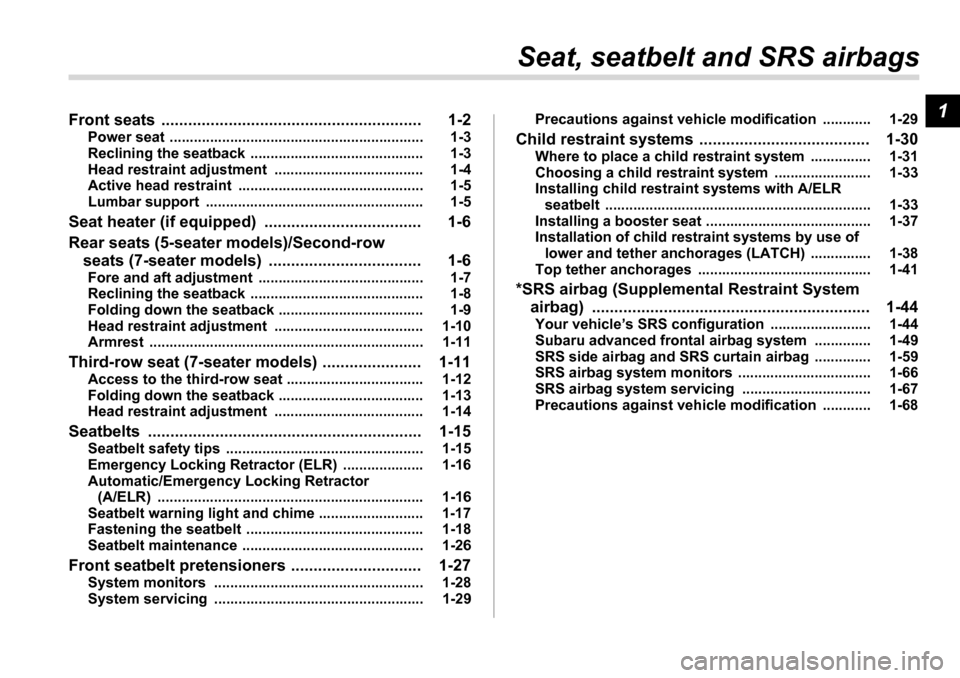
1
Seat, seatbelt and SRS airbags
Front seats .......................................................... 1-2 Power seat ............................................................... 1-3
Reclining the seatback ........................................... 1-3
Head restraint adjustment ..................................... 1-4
Active head restraint .............................................. 1-5
Lumbar support ...................................................... 1-5
Seat heater (if equipped) ................................... 1-6
Rear seats (5-seater models)/Second-row seats (7-seater models) .................................. 1-6Fore and aft adjustment ......................................... 1-7
Reclining the seatback ........................................... 1-8
Folding down the seatback .................................... 1-9
Head restraint adjustment ..................................... 1-10
Armrest .................................................................... 1-11
Third-row seat (7-seater models) ...................... 1-11 Access to the third-row seat .................................. 1-12
Folding down the seatback .................................... 1-13
Head restraint adjustment ..................................... 1-14
Seatbelts ............................................................. 1-15 Seatbelt safety tips ................................................. 1-15
Emergency Locking Retractor (ELR) .................... 1-16
Automatic/Emergency Locking Retractor (A/ELR) .................................................................. 1-16
Seatbelt warning light and chime .......................... 1-17
Fastening the seatbelt ............................................ 1-18
Seatbelt maintenance ............................................. 1-26
Front seatbelt pretensioners ............................. 1-27 System monitors .................................................... 1-28
System servicing .................................................... 1-29 Precautions against vehicle modification ............ 1-29
Child restraint systems ...................................... 1-30 Where to place a child restraint system ............... 1-31
Choosing a child restraint system ........................ 1-33
Installing child restraint systems with A/ELR seatbelt .................................................................. 1-33
Installing a booster seat ......................................... 1-37
Installation of child restraint systems by use of lower and tether anchorages (LATCH) ............... 1-38
Top tether anchorages ........................................... 1-41
*SRS airbag (Supplemental Restraint System airbag) .............................................................. 1-44Your vehicle’s SRS configuration ......................... 1-44
Subaru advanced frontal airbag system .............. 1-49
SRS side airbag and SRS curtain airbag .............. 1-59
SRS airbag system monitors ................................. 1-66
SRS airbag system servicing ................................ 1-67
Precautions against vehicle modification ............ 1-68
Page 31 of 377
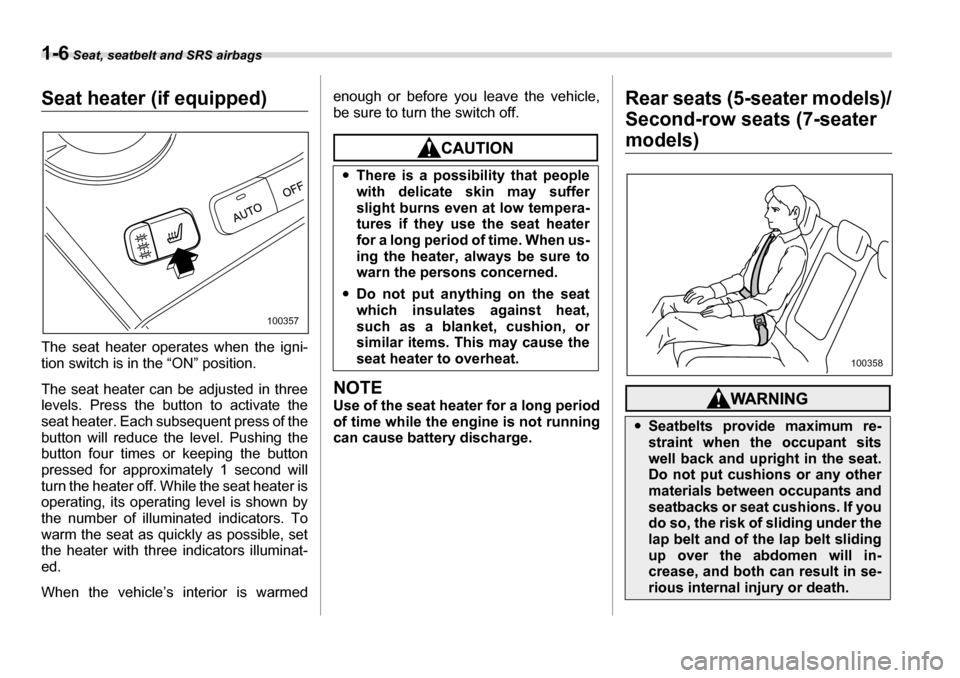
1-6 Seat, seatbelt and SRS airbags
Seat heater (if equipped)
The seat heater operates when the igni-
tion switch is in the “ON” position.
The seat heater can be adjusted in three
levels. Press the button to activate the
seat heater. Each subsequent press of the
button will reduce the level. Pushing the
button four times or keeping the button
pressed for approximately 1 second will
turn the heater off. While the seat heater is
operating, its operating level is shown by
the number of illuminated indicators. To
warm the seat as quickly as possible, set
the heater with three indicators illuminat-
ed.
When the vehicle’s interior is warmed enough or before you leave the vehicle,
be sure to turn the switch off.
NOTE
Use of the seat heater for a long period
of time while the engine is not running
can cause battery discharge.
Rear seats (5-seater models)/
Second-row seats (7-seater
models)
100357
�y
There is a possibility that people
with delicate skin may suffer
slight burns even at low tempera-
tures if they use the seat heater
for a long period of time. When us-
ing the heater, always be sure to
warn the persons concerned.
�y Do not put anything on the seat
which insulates against heat,
such as a blanket, cushion, or
similar items. This may cause the
seat heater to overheat.
�ySeatbelts provide maximum re-
straint when the occupant sits
well back and upright in the seat.
Do not put cushions or any other
materials between occupants and
seatbacks or seat cushions. If you
do so, the risk of sliding under the
lap belt and of the lap belt sliding
up over the abdomen will in-
crease, and both can result in se-
rious internal injury or death.
100358
Page 33 of 377
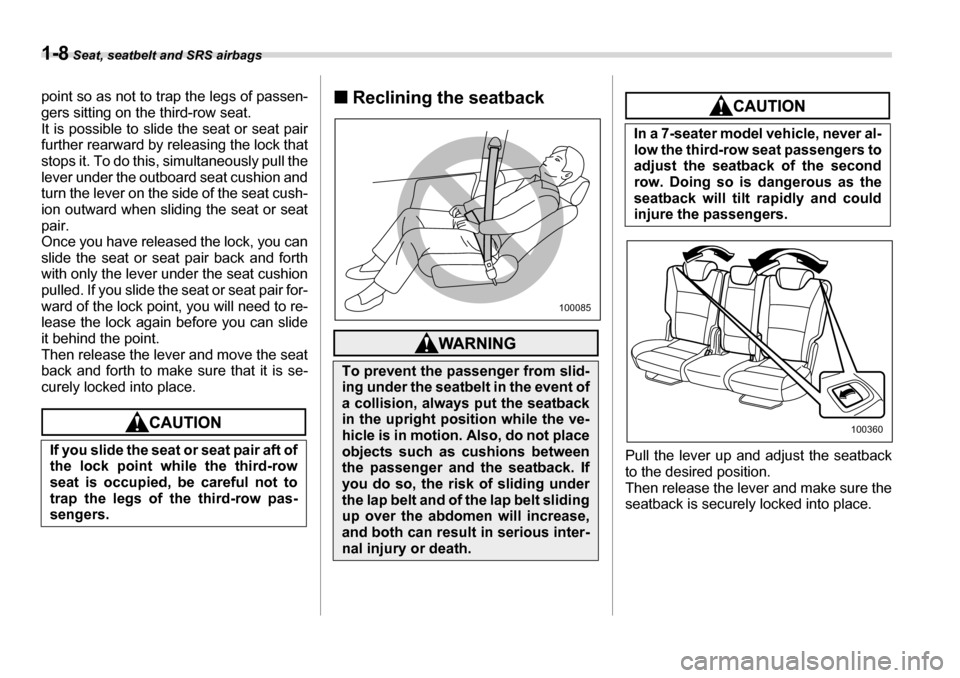
1-8 Seat, seatbelt and SRS airbags
point so as not to trap the legs of passen-
gers sitting on the third-row seat.
It is possible to slide the seat or seat pairfurther rearward by releasing the lock that
stops it. To do this, simultaneously pull the
lever under the outboard seat cushion and
turn the lever on the side of the seat cush-
ion outward when sliding the seat or seat
pair.
Once you have released the lock, you can
slide the seat or seat pair back and forth
with only the lever under the seat cushion
pulled. If you slide the seat or seat pair for-
ward of the lock point, you will need to re-
lease the lock again before you can slide
it behind the point.
Then release the lever and move the seat
back and forth to make sure that it is se-
curely locked into place.�„Reclining the seatback
Pull the lever up and adjust the seatback
to the desired position.
Then release the lever and make sure the seatback is securely locked into place.
If you slide the seat or seat pair aft of
the lock point while the third-row
seat is occupied, be careful not to
trap the legs of the third-row pas-
sengers.
To prevent the passenger from slid-
ing under the seatbelt in the event of
a collision, always put the seatback
in the upright position while the ve-
hicle is in motion. Also, do not place
objects such as cushions between
the passenger and the seatback. If
you do so, the risk of sliding under
the lap belt and of the lap belt sliding
up over the abdomen will increase,
and both can result in serious inter-
nal injury or death.
100085
In a 7-seater model vehicle, never al-
low the third-row seat passengers to
adjust the seatback of the second
row. Doing so is dangerous as the
seatback will tilt rapidly and could
injure the passengers.
100360
Page 41 of 377
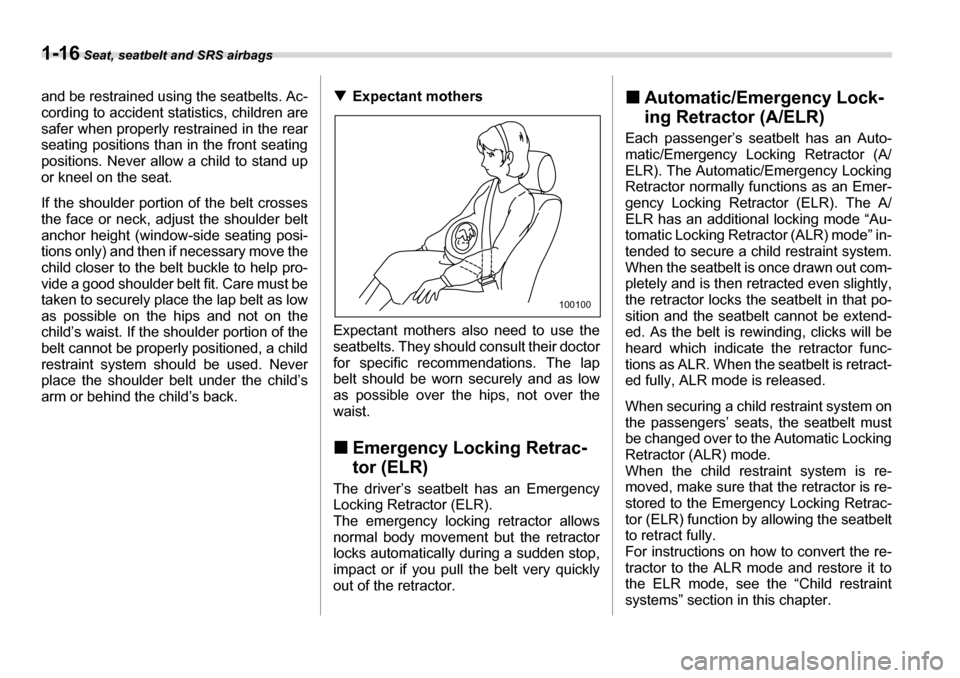
1-16 Seat, seatbelt and SRS airbags
and be restrained using the seatbelts. Ac-
cording to accident statistics, children are
safer when properly restrained in the rear
seating positions than in the front seating
positions. Never allow a child to stand up
or kneel on the seat.
If the shoulder portion of the belt crosses
the face or neck, adjust the shoulder belt
anchor height (window-side seating posi-
tions only) and then if necessary move the
child closer to the belt buckle to help pro-
vide a good shoulder belt fit. Care must be
taken to securely place the lap belt as low
as possible on the hips and not on the
child’s waist. If the shoulder portion of the
belt cannot be properly positioned, a child
restraint system should be used. Never
place the shoulder belt under the child’s
arm or behind the child’s back. �T
Expectant mothers
Expectant mothers also need to use the
seatbelts. They should consult their doctor
for specific recommendations. The lap
belt should be worn securely and as low
as possible over the hips, not over the
waist. �„ Emergency Locking Retrac- tor (ELR)
The driver’s seatbelt has an Emergency
Locking Retractor (ELR).
The emergency locking retractor allows
normal body movement but the retractor
locks automatically during a sudden stop,
impact or if you pull the belt very quickly
out of the retractor. �„
Automatic/Emergency Lock- ing Retractor (A/ELR)
Each passenger’s seatbelt has an Auto-
matic/Emergency Locking Retractor (A/
ELR). The Automatic/Emergency Locking
Retractor normally functions as an Emer-
gency Locking Retractor (ELR). The A/
ELR has an additional locking mode “Au-
tomatic Locking Retractor (ALR) mode” in-
tended to secure a child restraint system.
When the seatbelt is once drawn out com-
pletely and is then retracted even slightly,
the retractor locks the seatbelt in that po-
sition and the seatbelt cannot be extend-
ed. As the belt is rewinding, clicks will be
heard which indicate the retractor func-
tions as ALR. When the seatbelt is retract-
ed fully, ALR mode is released.
When securing a child restraint system on
the passengers’ seats, the seatbelt must
be changed over to the Automatic Locking
Retractor (ALR) mode.
When the child restraint system is re-
moved, make sure that the retractor is re-
stored to the Emergency Locking Retrac-
tor (ELR) function by allowing the seatbelt
to retract fully.
For instructions on how to convert the re-
tractor to the ALR mode and restore it to
the ELR mode, see the “Child restraint
systems” section in this chapter.
100100
Page 45 of 377

1-20 Seat, seatbelt and SRS airbags
�VAdjusting the front seat shoulder
belt anchor height
The shoulder belt anchor height should be
adjusted to the position best suited for the
driver/front passenger. To lower the an-
chor height, push the release button and
slide the anchor down. To raise the an-
chor height, slide the anchor up. Pull down
on the anchor to make sure that it is
locked in place.
Always adjust the anchor height so that
the shoulder belt passes over the middle
of the shoulder without touching the neck.
�V Unfastening the seatbelt
Push the button on the buckle.
Before closing the door, make sure that
the belts are retracted properly to avoid
catching the belt webbing in the door. �T
Rear seatbelts (5-seater models)/
Second-row seatbelts (7-seater
models) – excluding center seatbelt
1. Sit well back in the seat.
2. Pick up the tongue plate and pull the
belt out slowly. Do not let it get twisted. If
the belt stops before reaching the buckle,
return the belt slightly and pull it out more
slowly. If the belt still cannot be unlocked,
let the belt retract slightly after giving a
strong pull on it, then pull it out slowly
again.
3. Insert the tongue plate into the buckle
until you hear a click.
100374
When wearing the seatbelts, make
sure the shoulder portion of the
webbing does not pass over your
neck. If it does, adjust the seatbelt
anchor to a lower position. Placing
the shoulder belt over the neck may
result in neck injury during sudden
braking or in a collision.
100105100102
Page 46 of 377
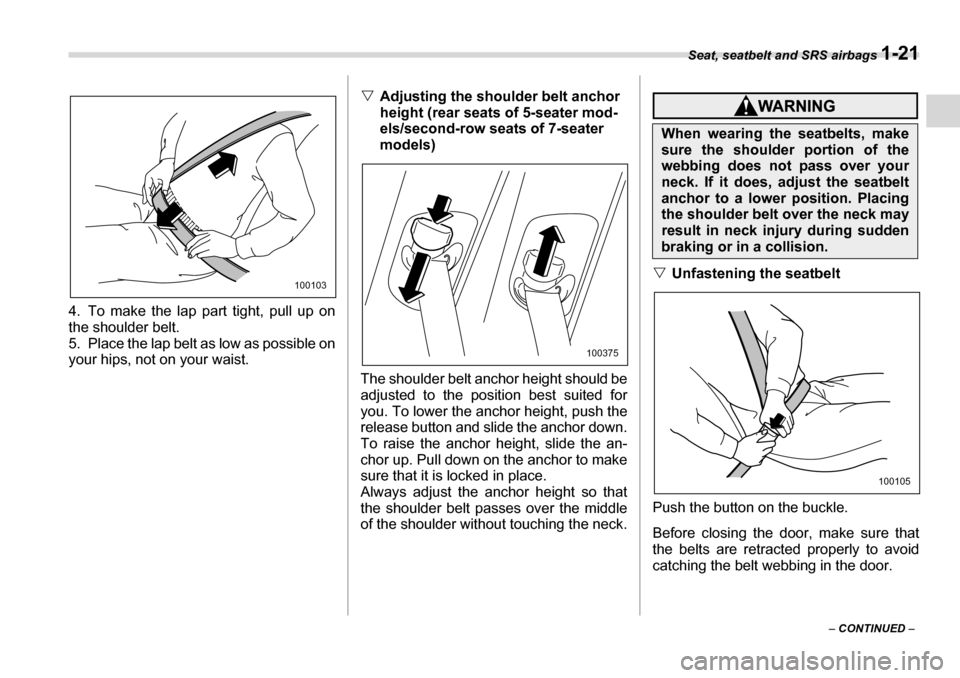
Seat, seatbelt and SRS airbags 1-21
– CONTINUED –
4. To make the lap part tight, pull up on
the shoulder belt.
5. Place the lap belt as low as possible on
your hips, not on your waist.
�V
Adjusting the shoulder belt anchor
height (rear seats of 5-seater mod-
els/second-row seats of 7-seater
models)
The shoulder belt anchor height should be
adjusted to the position best suited for
you. To lower the anchor height, push the
release button and slide the anchor down.
To raise the anchor height, slide the an-
chor up. Pull down on the anchor to make
sure that it is locked in place.
Always adjust the anchor height so that
the shoulder belt passes over the middle
of the shoulder without touching the neck.
�V Unfastening the seatbelt
Push the button on the buckle.
Before closing the door, make sure that
the belts are retracted properly to avoid
catching the belt webbing in the door.100103
100375
When wearing the seatbelts, make
sure the shoulder portion of the
webbing does not pass over your
neck. If it does, adjust the seatbelt
anchor to a lower position. Placing
the shoulder belt over the neck may
result in neck injury during sudden
braking or in a collision.
100105
Page 47 of 377
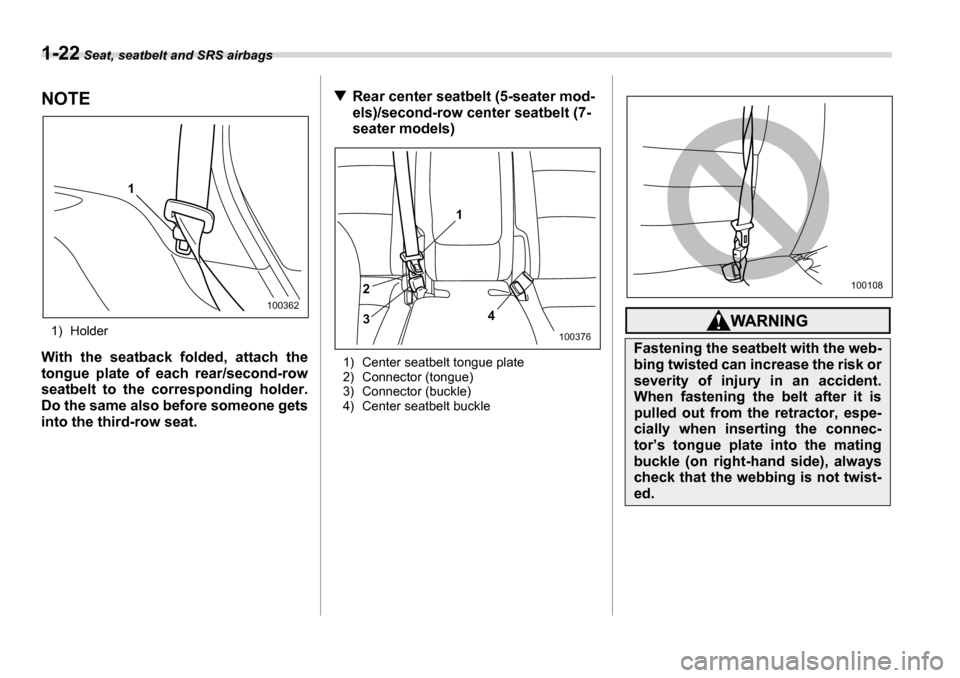
1-22 Seat, seatbelt and SRS airbags
NOTE
1) Holder
With the seatback folded, attach the
tongue plate of each rear/second-row
seatbelt to the corresponding holder.
Do the same also before someone gets
into the third-row seat. �T
Rear center seatbelt (5-seater mod-
els)/second-row center seatbelt (7-
seater models)
1) Center seatbelt tongue plate
2) Connector (tongue)
3) Connector (buckle)
4) Center seatbelt buckle
1
100362
1
2 3 4
100376Fastening the seatbelt with the web-
bing twisted can increase the risk or
severity of injury in an accident.
When fastening the belt after it is
pulled out from the retractor, espe-
cially when inserting the connec-
tor’s tongue plate into the matingbuckle (on right-hand side), always
check that the webbing is not twist-
ed.
100108
Page 55 of 377

1-30 Seat, seatbelt and SRS airbags
Child restraint systems
While riding in the vehicle, infants and
small children should always be placed in
an infant or child restraint system in one of
the rear seating positions recommended
in this owner’s manual. You should use an
infant or child restraint system that meets
Federal Motor Vehicle Safety Standards
or Canada Motor Vehicle Safety Stan-
dards, is compatible with your vehicle and
is appropriate for the child’s age and size.
All child restraint systems are designed to
be secured in vehicle seats by lap belts or
the lap belt portion of a lap/shoulder belt
(except those covered under the section
in this manual, entitled “Installation of child
restraint systems by use of lower and teth-
er anchorages (LATCH)”). Children could be endangered in an acci-
dent if their child restraints are not proper-
ly secured in the vehicle. When installing
the child restraint system, carefully follow
the manufacturer’s instructions.
According to accident statistics, children
are safer when properly restrained in the
rear seating positions than in the front
seating positions.
All U.S. states and Canadian provinces
require that infants and small children be
restrained in an approved child restraint
system at all times while the vehicle is
moving.
�y
Installation of a tire of different
size and construction from the
tires specified on the vehicle plac-
ard attached to the door pillar or
specified for individual vehicle
models in this Owner’s Manual.
100500
100125